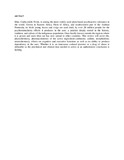| dc.description.abstract | Khat, Catha edulis Forsk, is among the most widely used plant-based psychoactive substance in the world. Grown in Eastern Africa, Horn of Africa, and southwestern part of the Arabian Peninsula, its fresh young leaves and twigs are used daily by over 20 million people for the psychostimulatory effects it produces in the user, a practice deeply rooted in the history, tradition, and culture of the indigenous population. Once hardly known outside the regions where it is grown and used, khat use has now spread to other countries. This review will cover the, phytochemistry, pharmacokinetics of the active ingredients—cathinone, cathine, norephedrine, neurochemistry, effects on cognitive and executive functions as well as its ability to produce dependency in the user. Whether it is an innocuous cultural practice or a drug of abuse is debatable as the preclinical and clinical data needed to arrive at an authoritative conclusion is lacking. | en_US |

